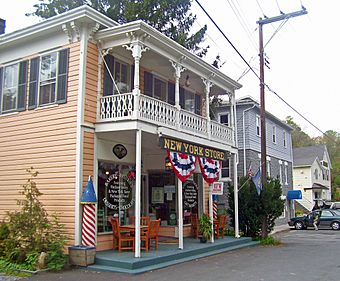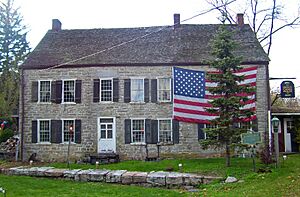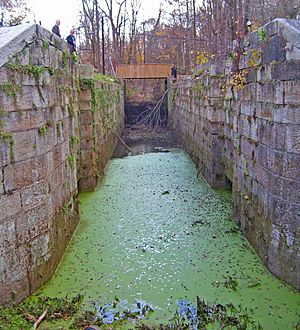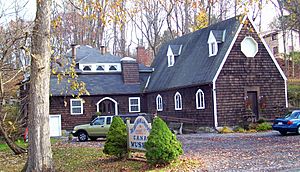High Falls Historic District facts for kids
Quick facts for kids |
|
|
High Falls Historic District
|
|

Dales Store and other buildings on Main Street, 2008
|
|
| Location | High Falls, NY |
|---|---|
| Nearest city | Kingston |
| Area | 21 acres (8 ha) |
| Built | 1790–1940 |
| Architectural style | Various |
| NRHP reference No. | 98001005 |
| Added to NRHP | 1998 |
The High Falls Historic District is a special area in the small community of High Falls. It's located in Marbletown, New York. This district covers about 21 acres (8 hectares). It's found where several roads meet, including NY 213 and Main Street.
This area is important because the Delaware and Hudson Canal used to run through it. The canal once crossed the Rondout Creek on a huge bridge called an aqueduct. This aqueduct burned down a long time ago and was never rebuilt. You can still see parts of the old canal here, like some well-preserved locks. These locks helped boats move up and down the canal. The district is a great example of how towns grew in the mid-1800s.
What Makes Up the High Falls Historic District?
The High Falls Historic District is shaped a bit unevenly. It centers around the main road intersection. The district includes many buildings along Route 213 and Bruceville Road. It also covers the path where the old canal used to be.
Inside this district, there are 33 buildings. Most of these buildings are very old and add to the area's historic feel. Only four buildings are considered "non-contributing," meaning they don't fit the historic look. There are also five structures that are former canal locks.
The buildings in the district were built between the late 1700s and the mid-1900s. The canal structures were mostly built in the mid-1800s. Most of the area is developed, but a small part of the canal bed is still wooded.
A Look Back: History of High Falls
High Falls gets its name from a large waterfall on the nearby Rondout Creek. This waterfall provided great water power. This attracted millers to the area even during colonial times. The first bridge to Stone Ridge was built around this time. The stone Jacob DePuy House, built in 1797, shows what homes looked like back then.
In the early 1800s, a factory in High Falls made cotton and woolen goods. This made the hamlet a local manufacturing hub. Then, in 1828, the Delaware and Hudson Canal opened. This canal was built to move anthracite coal from Pennsylvania to New York City. The coal went through Kingston and then onto ships on the Hudson River.
High Falls became very important for the canal. It was a key crossing point for water. A famous engineer, John A. Roebling, designed the aqueduct here. Also, natural cement was found nearby in Rosendale. This cement was needed for the canal's construction.
The canal transformed High Falls. It changed from a quiet farming community to a busy industrial town. This was especially true after the canal was made bigger in 1850. This allowed larger barges to use it. The canal company built things like a lock tender's house and a general store. Small shops also opened to serve the canal traffic. The layout of the streets and blocks still shows this history today.
When the canal stopped operating in 1899, development slowed down. The district has not changed much since then. The state did move a part of Route 213 in 1956. High Falls also became a popular vacation spot. People would travel here by carriage to connect with the canal or trains.
Today, High Falls is still a popular place for visitors. Many people from New York City have second homes here. The shops and stores now include boutiques and restaurants. They cater to tourists on weekends and in the summer.
Important Buildings in the District
Several buildings and structures in the High Falls Historic District are very important. Three canal locks and two other canal structures are part of a special national landmark. Here are some of the notable properties:
- Delaware and Hudson Canal Museum, 23 Mohonk Road. This building was once a church. It was built in the 1880s and became a museum in the 1960s. It teaches about the history of the canal.
- Depuy Canal House, 1315 Route 213. This home and tavern was built in 1797. It's now a well-known restaurant.
- DeGraff House, 1304 Route 213. This fancy brick house was built in 1855. It has an Italianate style.
- Dutch Reformed Church Parsonage, 1300 Route 213. This building was built in 1875 in the Greek Revival style. It is also now a restaurant.
- Hasbrouck Barn and Dwelling, 121–125 Main Street. This beautiful Greek Revival home was built in the mid-1800s. Its barn has been changed into a home.
- I. Hasbrouck House and Store, 5-7 Second Street. The canal company built this two-story building around 1850. It was used as a feed store. You can still see the original storefronts.
- High Falls Reformed Church, 4 Firehouse Road. This two-story brick church was built in 1867.
- J.B. Shaw House, 17 Mohonk Road. This brick house was built in 1875. It has some Greek Revival features. The property also has smaller buildings, including an older lock tender's shelter.
- I.H. Snyder Store, 1209 Route 213. Built around 1875, this two-story building has an Italianate style. It also has its original storefront.
- Temperance House, 1205 Route 213. The Quick family ran this as the Cliff House from 1895 to 1949. It has a large open porch.
- Towpath House, 6-8 Second Street. This is the oldest building in the district, built in 1787. The canal company added onto it in 1820.






